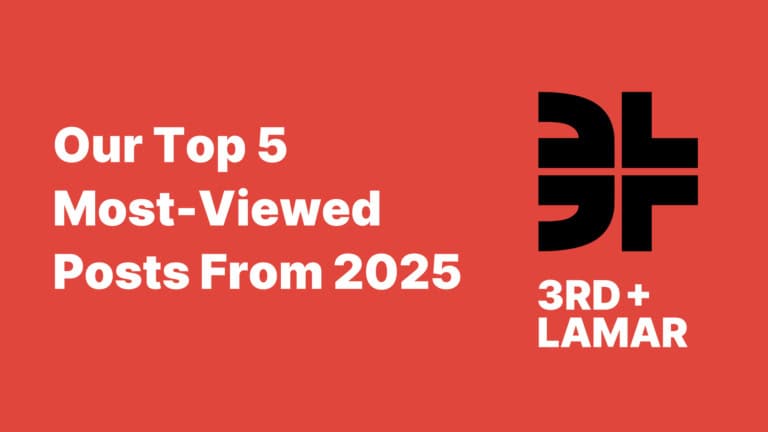
This blog is for anyone who is starting (or considering starting) a new business.
Launching a business is sort of like Super Mario. There’s an initial adrenaline rush of firing up the Nintendo, and then you figure out how to approach each challenge to stave off death and reach the next level.
We’re on Level I of 3rd & Lamar, and the most painstaking part so far has been the search for insurance benefits. Ironically, it’s been full of smoke-and-mirrors, misdirection, and landmines – similar to what you may encounter in a video game.
This is my experience and advice for anyone about to go through this.
Do Not Accept COBRA Insurance At Face Value
In April 2019, I resigned from my job to pursue 3rd & Lamar. My wife is a Type I diabetic, and we have two children. Sorting out COBRA insurance with my previous insurer, United Health Group (UHG), was a priority.
To remain on our UHG plan would have cost roughly $2k per month in premiums for my family. Any cheaper plans had serious tradeoffs. A plan that worked price-wise lacked coverage for certain physicians or medications. A plan that covered each medication was too costly.
Over a few weeks and after I spoke to multiple UHG reps and an independent insurance broker, a UHG rep sensed my exasperation and presented a new option, something no one had mentioned before.
My wife could remain on UHG’s COBRA plan alone, while my children and I could select a lower-cost HMO plan on the open market. This saved us $700 per month in premiums!
I assume UHG didn’t present this as an option initially because they make more money if my whole family is insured through them. None of the materials that UHG sent to me discussed COBRA coverage on a per-person basis. It was my whole family or nothing, or so it seemed.
Lesson 1: With COBRA insurance, you may have more options than what is initially presented to you. Don’t wait to find out.
Manage Your Expectations And Anticipate Delays
COBRA lasts only 18 months, so my next priority was to launch 3rd & Lamar and secure a benefits provider for the company and its employees: Tony Stolfa, Heather Grass, and I.
In the world of business benefits, there are PEOs and non-PEOs. You can research the differences, but the most important factors for us in choosing a PEO were:
- We knew people who used ADP (a PEO), and they didn’t complain about it.
- We wanted to streamline our number of vendors (i.e. payroll, insurance, 401k, etc.).
- ADP gave us a single point of contact for all of our needs.
- We wanted access to the best healthcare plans, which PEOs often offer.
- ADP has a variety of vendor discounts that we’d have access to.
Sounds simple enough, but to get to this point took dozens of hours. We spoke to Justworks, Rippling, Paychex, etc. One email triggered a phone call, which led to five follow-up emails, and so on. Vendors badmouthed each other (sales tip: try selling on your merits instead), leading to second-guessing and suspicion. As sales processes go, this was high touch, confusing, and inconvenient.
Part of the problem is that information was presented in bits and pieces, and each vendor has a custom pricing model with nuances that distinguish it from competitors. Making an apples-to-apples comparison between vendors requires a major investment of time and energy.
Lesson 2: Finding a benefits provider is not like choosing an email tool. Expect it to take twice as long as you think.
Do Not Get Blindsided By ADP
This is not a story evangelizing for ADP, a 65,000-person company that is (predictably) full of bureaucracy and cumbersome policies that are not super user-friendly.
If your main point of contact is not available, you can’t speak to anyone else who can pick up where they left off. There doesn’t seem to be a central CRM for other sales reps to reference.
Also, I tried calling customer support, and I was told there isn’t a company directory to transfer my call to my specific sales rep. I got caught on hold for >30 minutes on separate occasions trying to reach an ADP rep when I got smart, pretended I was a prospective customer (instead of a returning customer), and spoke to a human immediately.
Quick aside: It says something about what a company values when you can directly speak to a human in sales, but you’re routed through a phone tree for customer support.
Anyways, ADP charges a commission based on your average payroll. What we’re paying is not what ADP initially offered. We had to negotiate. When companies use this approach, it damages trust. Now, anything ADP offers, I question whether it’s the best possible deal or if I should haggle.
If you’re considering ADP, here are other things to keep in mind that we didn’t realize until late in the game:
- Whatever rate you negotiate, you can lock it in for one or two years before ADP can raise it. If you lock it in for two years and you leave early, there’s a financial penalty.
- If you have 2-4 employees, everyone must choose the same medical and dental plans. So we’re all on the exact same coverage with the exact same provider, which is limiting. At 5-9 employees, your company can offer two medical and dental plans to employees. Once you reach 10+ employees, your company can offer three medical and dental plans.
- If you just started your company and you don’t have a long payroll history, ADP will require one of the following:
- A corporate “Guarantee” through a potential sister business that has been established for > 1 year. This business can co-sign for you.
- A letter of credit from a bank.
- A deposit that ADP holds onto for 12 months. This deposit is based on 120% of the average monthly payroll dollars for your company.^
- There is a one-time $1,800 implementation fee that was not mentioned to us until after we signed. It’s possible that we missed this in the fine print of the dozens of forms we signed and reviewed.
- If you join ADP after the 1st of the month, you can’t activate your benefits until the start of the next month.*
- For medical insurance premiums, the minimum the business must pay for is 75% in order to qualify. For dental/vision insurance, these can be 100% employee paid.*
^The purpose of this deposit is in case your business defaults on paying employees, then ADP is still on the hook and they will utilize the deposit funds to pay the employees.
*These policies are likely industry-wide.
We stuck with ADP because we were too far down the rabbit hole (>120 emails with ADP alone) and had no confidence that other vendors would provide a better, more efficient experience. We didn’t want the back-and-forth to last a day longer than it needed to.
Lesson 3: The entire benefits-search process is a good test to see how badly you want to start a business. If you’re not that serious about your company, you won’t endure this colossal waste of time. That said, this process shouldn’t be so painful that it serves as a deterrent to would-be entrepreneurs.
I’m thrilled to be past this point. I’m sure this won’t be the last time we have to deal with this, though.
For now, we’re looking forward to whatever Level II entails 🙂
ICYMI – here are some helpful links if you’re considering Aetna plans:
- Find out if your doctor is in-network or out of network: http://www.aetna.com/docfind
- Find out what price tier your prescription medications are on by clicking here.



